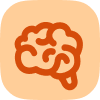Ticking Sound
Our training methodology uses multi-sensory training to enhance the effectiveness of our training. The ticking metronome sound helps the brain pace itself as it reads. Additionally, the repetitive ticking sound stimulates the brain and helps to create memory and familiarity with the training, helping the brain to form stronger, deeper neural connections and sponsor improvements in reading and cognitive performance.
Moving Objects
The exercises where objects move across the screen in a variety of patterns are a foundational aspect of our training. As your eyes move from left to right, top to bottom, and corner to corner, it stimulates the brain and trains the eyes to work more effectively together. Your eyes are cross-connected to your brain. This means that your left eye is connected to the right side of your brain and your right eye is connected to the left side. As you track these movements with your eyes, it stimulates your brain in different areas. Additionally, some studies have shown that as stimulation crosses the corpus callosum (the division between temporal and parietal portions of your brain), it improves brain activity, cognition, memory and other key brain functions. This same style of training is used to help victims of Traumatic Brain Injuries to relearn several basic functions and improve their brains’ overall functionality.
Expanding Shapes Exercises
The expanding shape exercises are designed to expand your field of vision. This is the area of your vision that you can see clearly. Most people, when they read, focus on about three letters at a time. The average length of most words in the English language is 4.7 characters, with many words being much longer than this. What this means is that we are inefficient readers simply because we cannot take in enough information to even read one word in a single glance. The exercises where you see expanding shapes such as ovals and squares which expand in concentric circles outward from the center, help you to expand that area you see in clarity, helping you begin to see and process more letters in a single glance. If you can see up to 8-10 letters in clarity, then you will more than double your reading speed, and increase your reading comprehension as you see and process information more rapidly and accurately. Plus, this exercise is very mentally challenging. This is not something we do in our normal day-to-day lives. Because of this, our brains have to think about how to properly do this new function. This stimulates the brain and forms new neural pathways.
To correctly do this exercise, begin by looking at the shape in the center of the screen. As you see the rings start to expand outward from the center, keep your eyes looking on the shape, but try to keep the expanding rings in focus as they get further and further from the middle. It will feel like your eyes are getting wider and wider as the rings expand. With time, this exercise will make you a much more efficient reader and will activate your brain!
Rapid Eye Movement
All of our vision and reading exercises train the eyes to move rapidly from side to side. This trains your eyes to make quick, fluid movements. This rapid movement is critical to increasing your reading speed. Our eyes process information much like an old movie projector that uses film strips. Our eyes take pictures of what they see and as we move our eyes, those pictures get stiched into fluid movement by our brains. These mental pictures are tiny jumping movements made by our eyes as we move them in our sockets. These tiny movements are called saccades. You experience them right now. Simply close one eye and very gently place your finger on your eyelid. Now keep reading this paragraph. You’ll find that rather than making a single, smooth and fluid motion, as you read, your eyes are actually making short little jumps from left to right as you read, then one big jump from right to left as you get to the end of one line and move to start again on a new line. As you do this, you’ll be able to feel those tiny movements your eyes are making!
Rapid eye movement can help you to make those movements more fluid, and over time, hopefully help you to make fewer of them as you take in more information in a single glance. Additionally, this eye movement stimulates your brain and helps you to form new neural pathways as you push yourself to adapt to a new, more efficient way of reading.
Alternating Speeds
One of the core principles in our training method is alternating the speed at which the exercises are animated. This can be frustrating if you don’t understand the purpose of these alternating speeds, and don’t know how to do the exercises. Don’t worry! We’ll give you all the details you need.
In professional sports, it is very common for athletes to challenge themselves in practice harder than they’ll actually need to play in their games. Another example of this would be baseball players who put weights on their bats during practice to get their muscles used to swinging a heavier bat. Then when they get up to bat in the game and they swing, their muscles swing harder, producing a more powerful swing that can send the ball flying farther into the outfield. Another example would be basketball players who strap weights to their ankles when they practice their jumping. As they train, their muscles work harder to jump with heavier weights. When the weights are removed, the players can jump higher because their muscles have trained harder.














